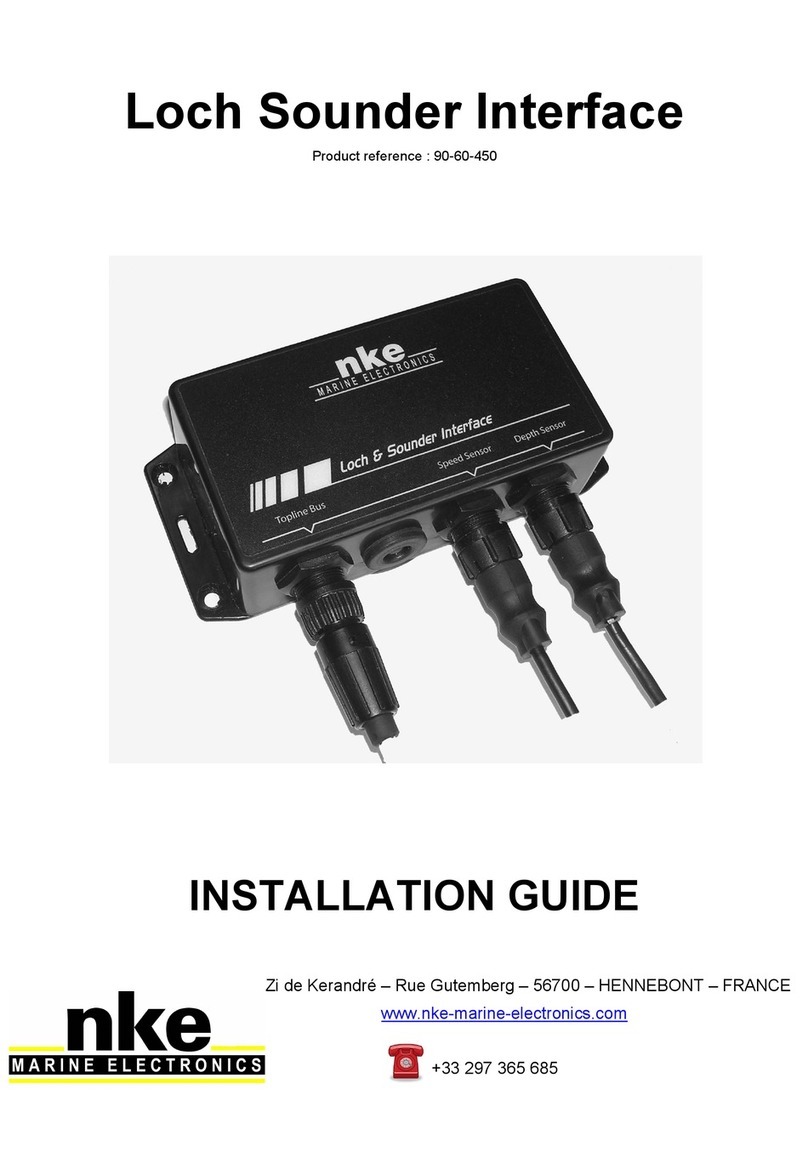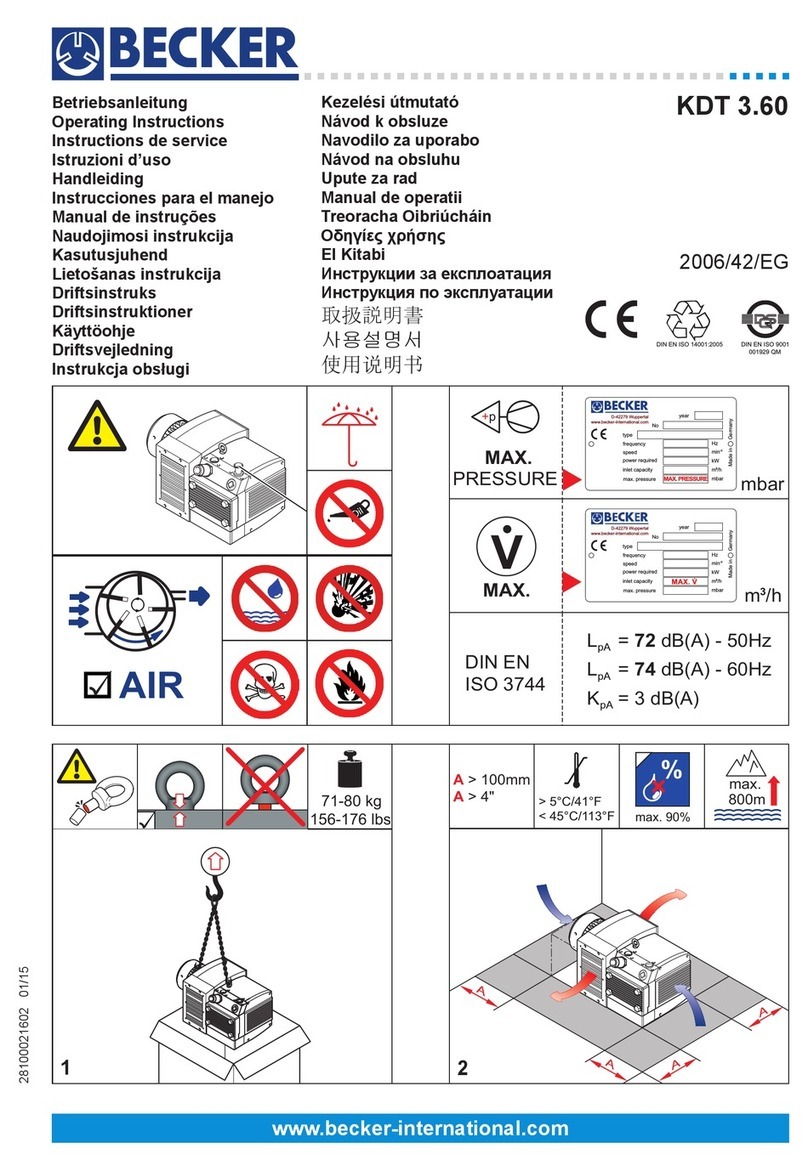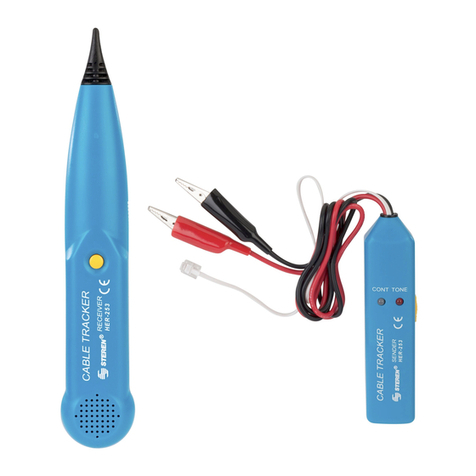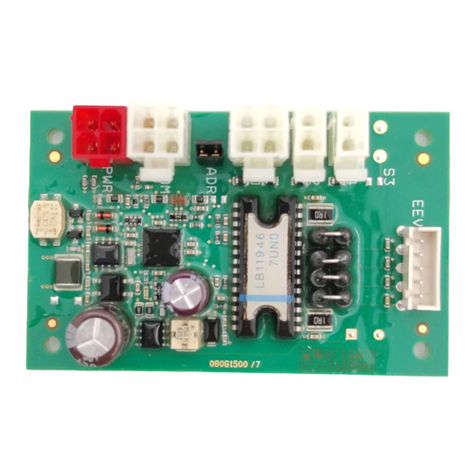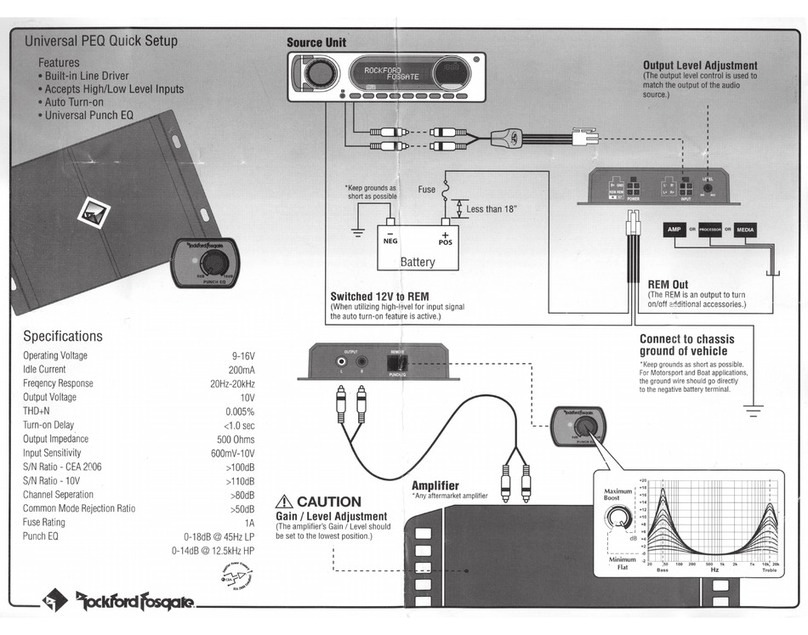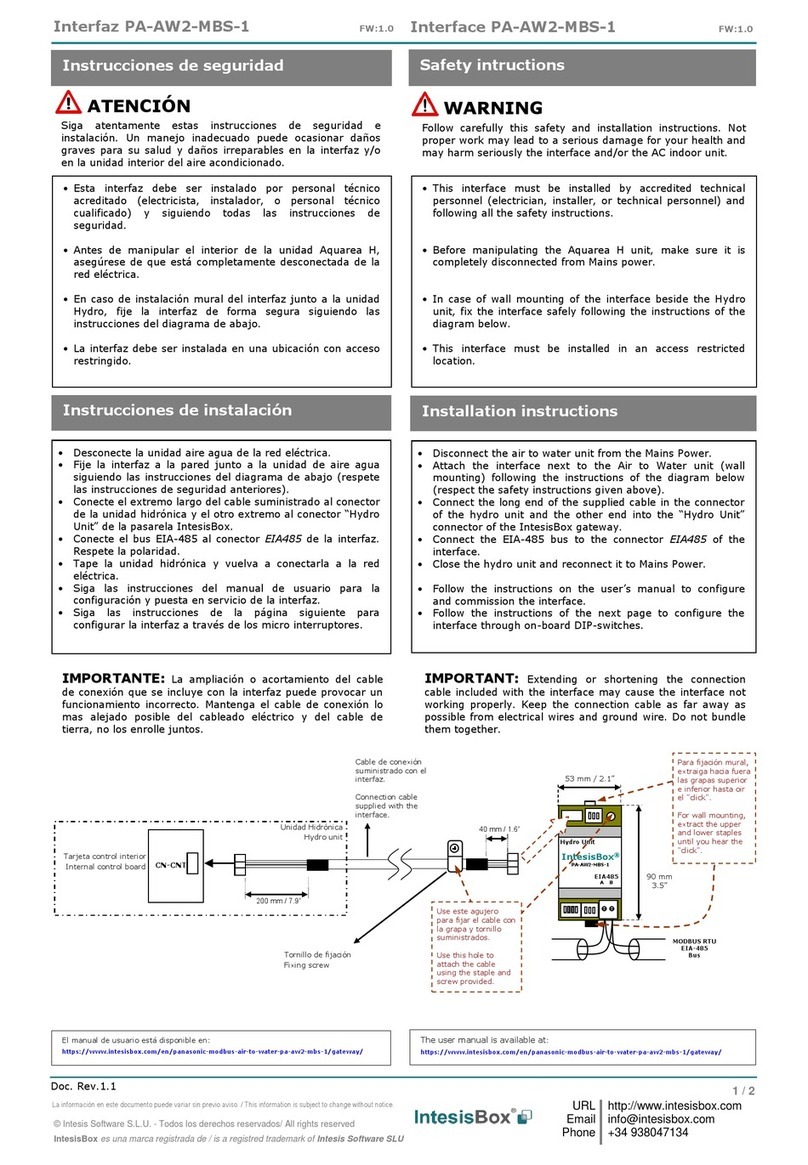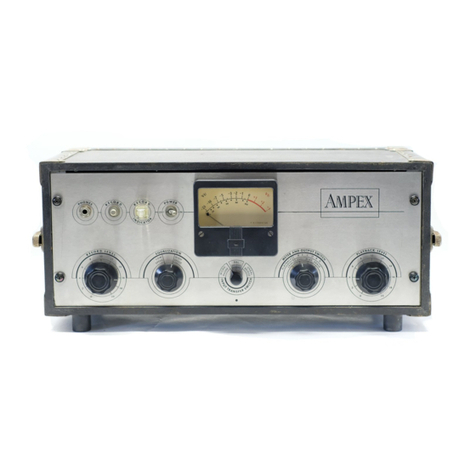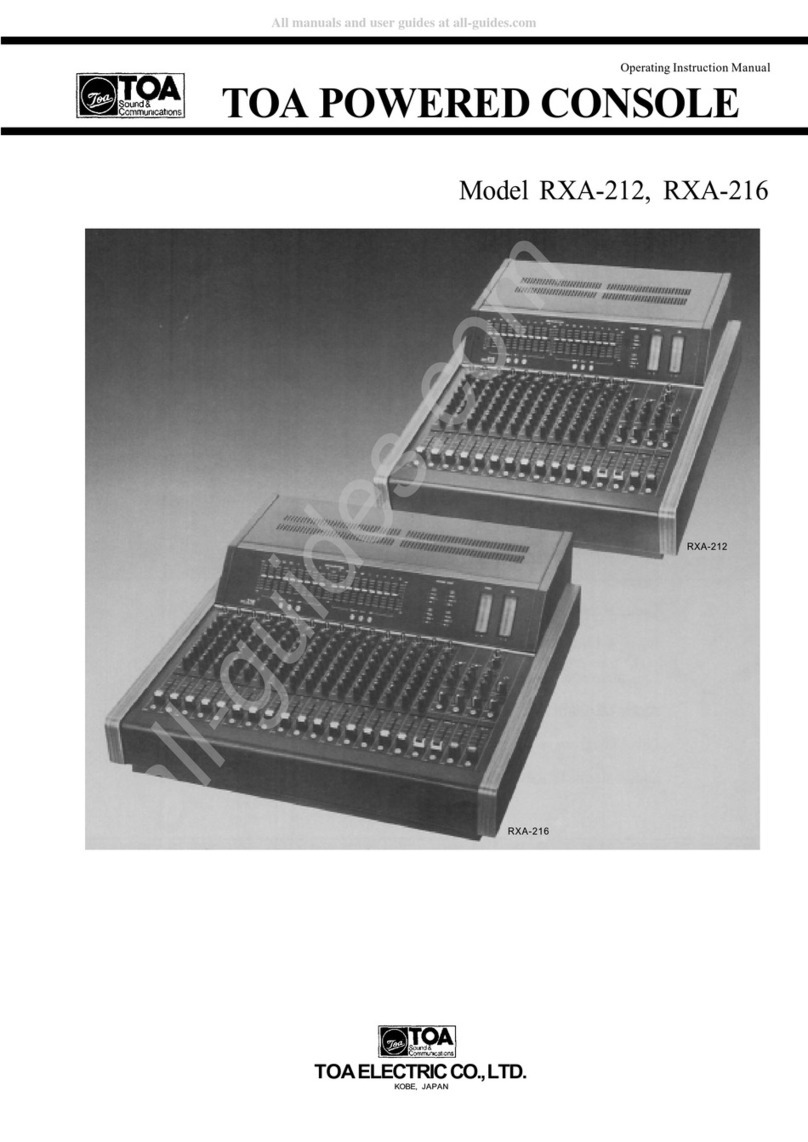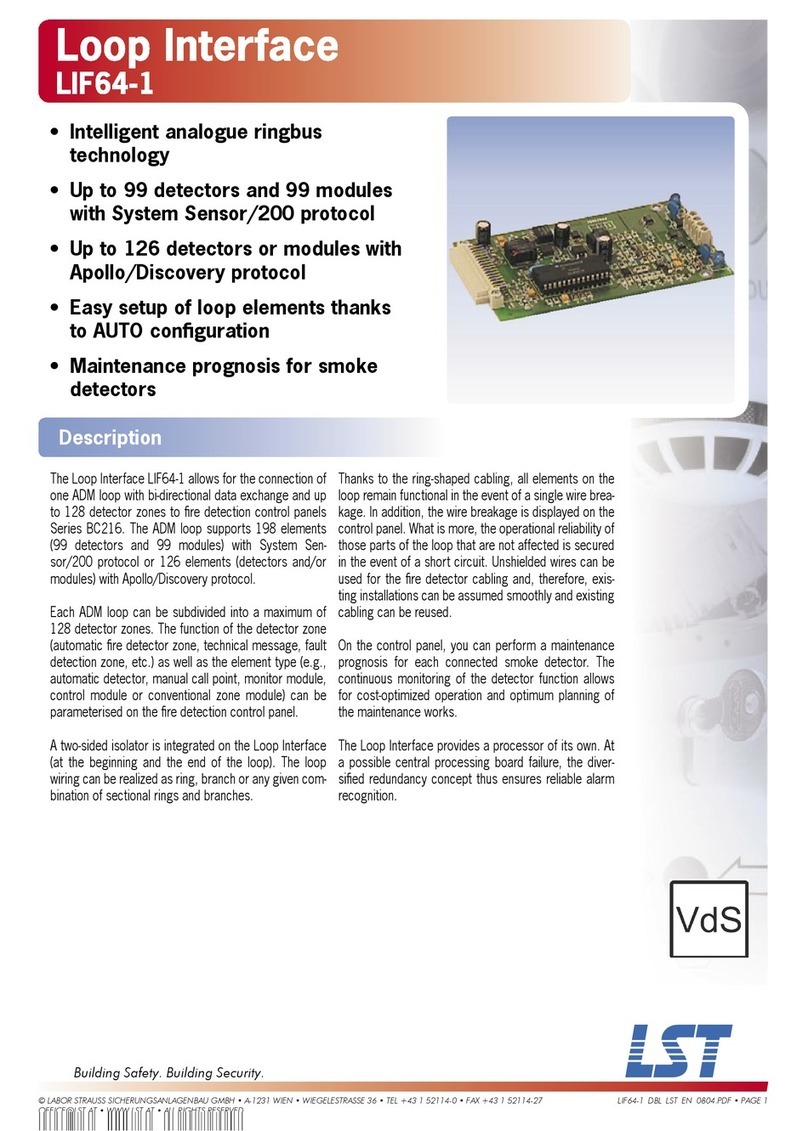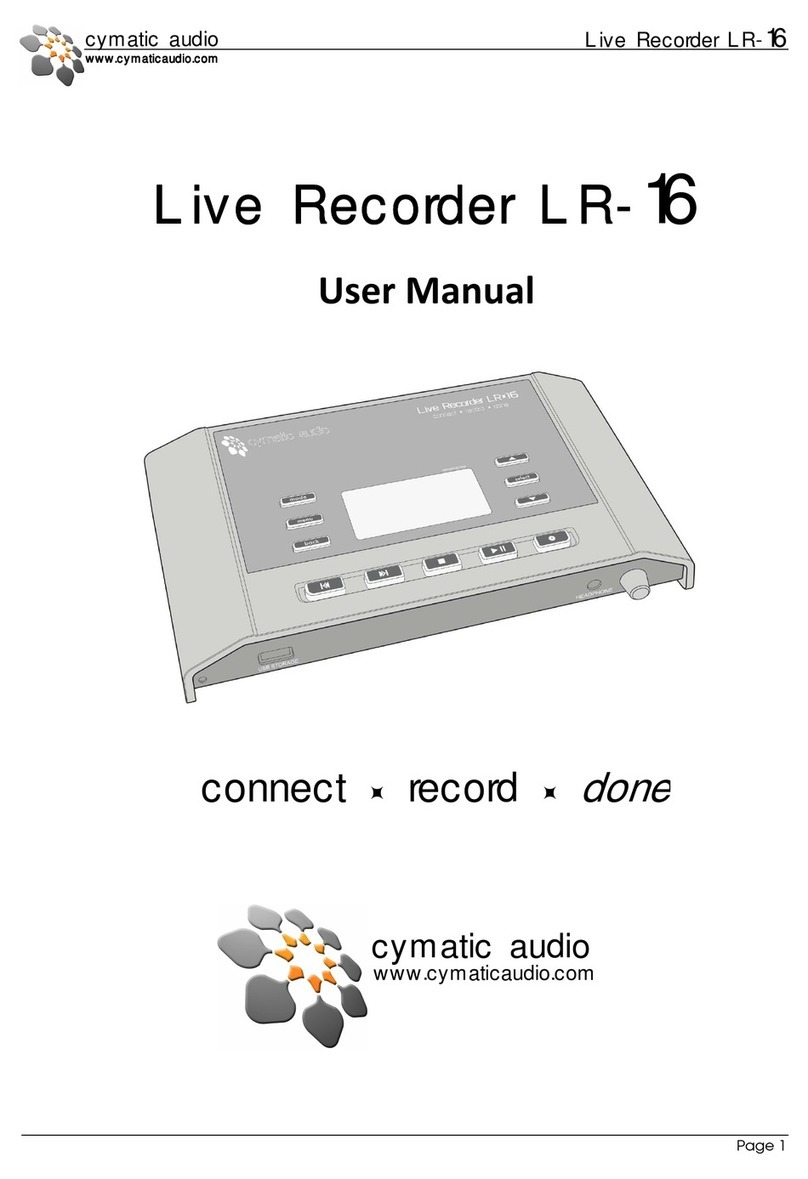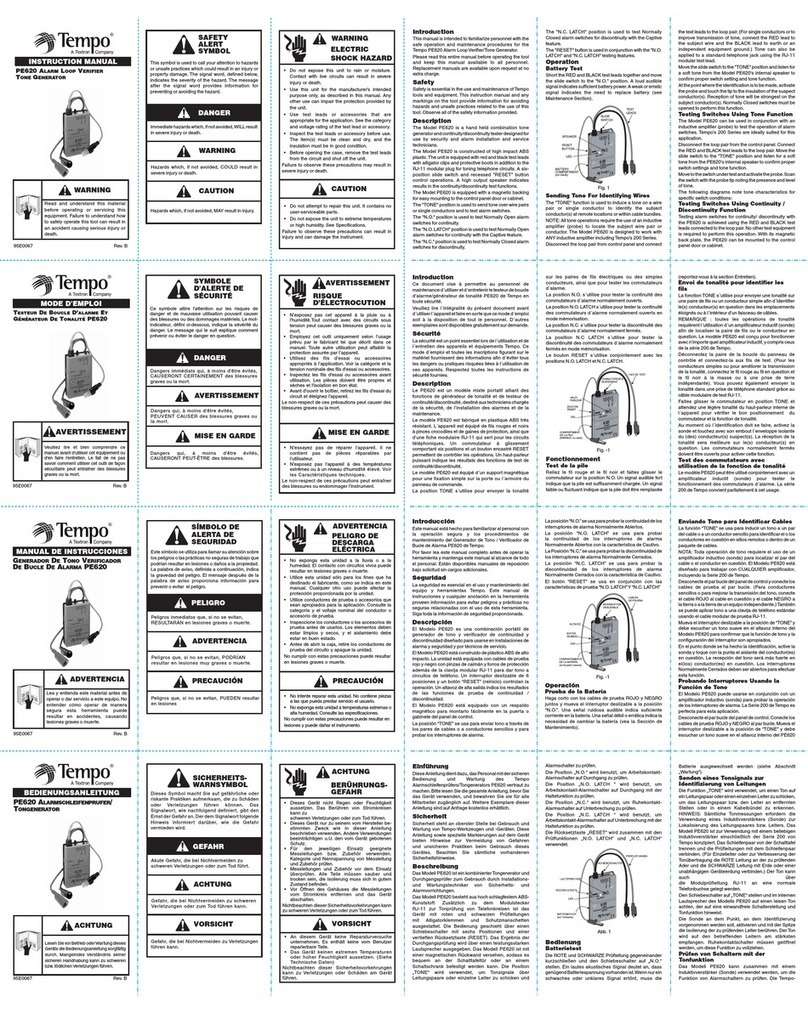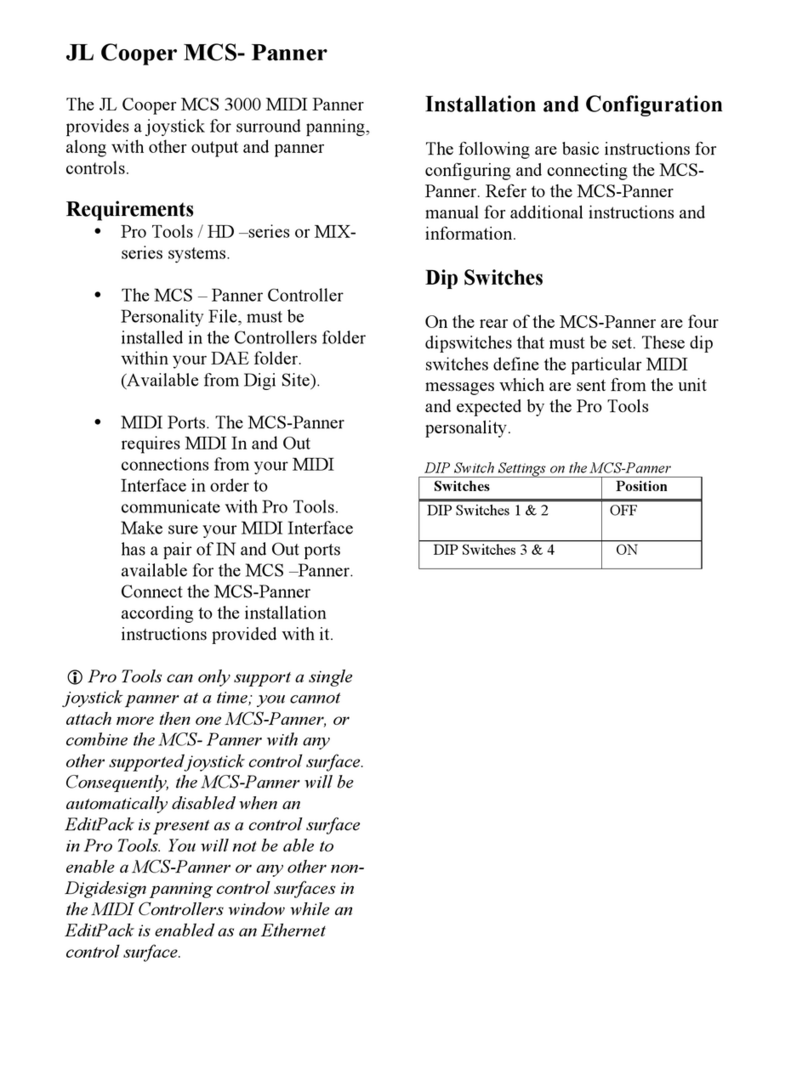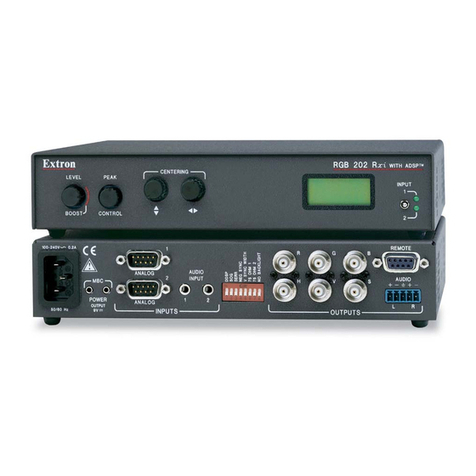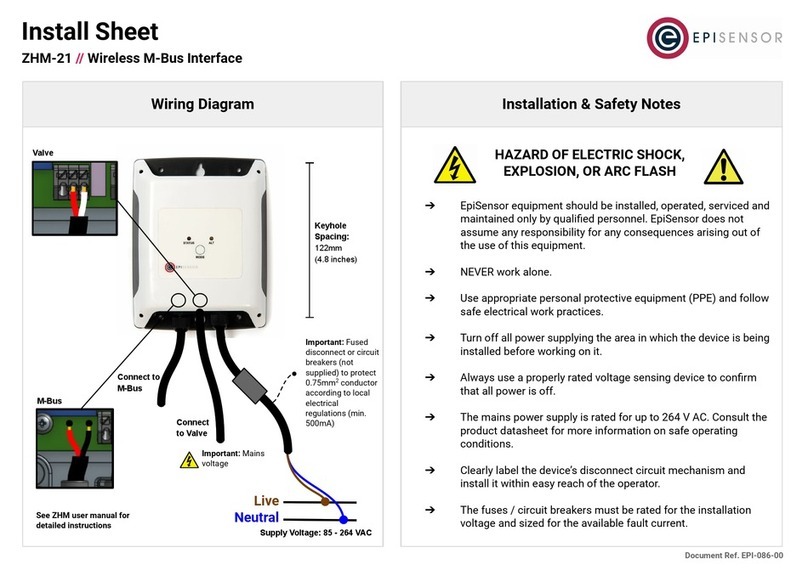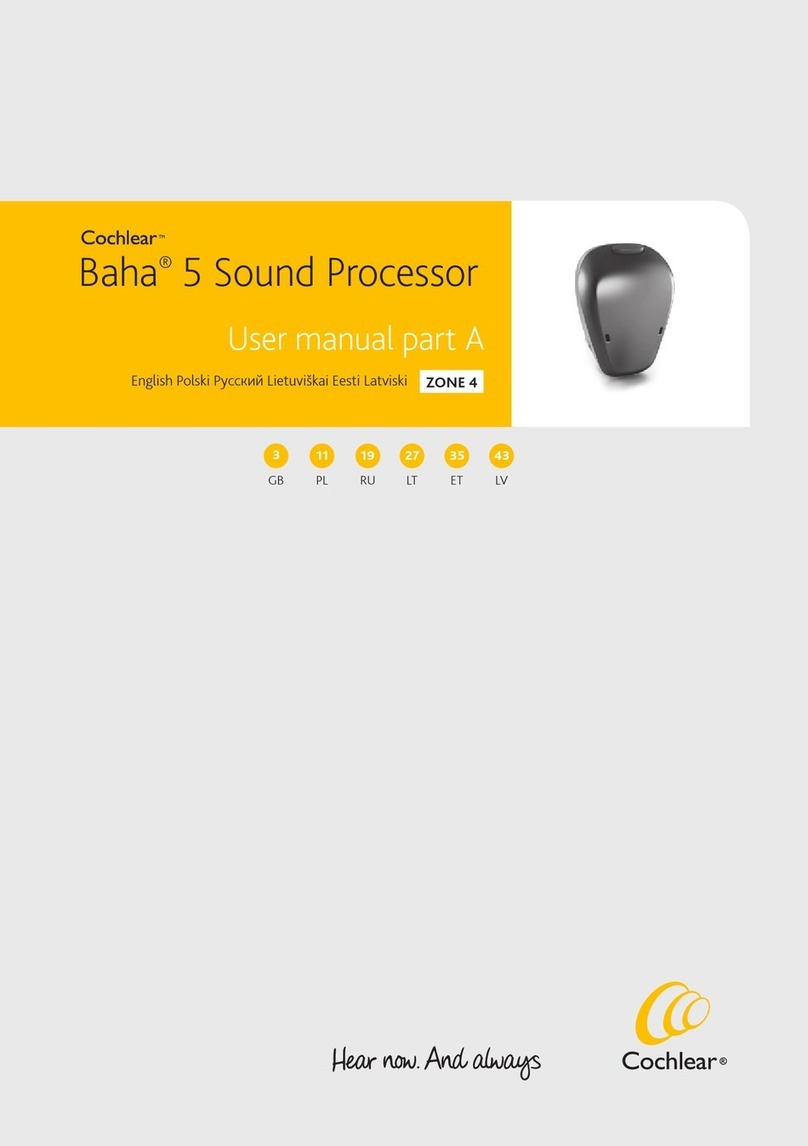NKE NMEA 183 Troubleshooting guide

nke
–
Sailing competition
Z.I. Kerandré – Rue Gutenberg – 56700 HENNEBONT- FRANCE
http://www.nke.fr – After sale service n°33 297 365 685
NMEA 183 output interface
Product reference: 90-60-357
USER GUIDE
&
INSTALLATION GUIDE

-
2
-NMEA output interface user guide 183 33-60-357-001 REV1
TABLE OF CONTENTS
1
PRESENTATION .................................................................................................................................... 3
2
INFORMATION CONVERTED BY THE NMEA OUTPUT INTERFACE................................................ 3
3
FRAMES TRANSMITTED BY THE NMEA OUTPUT INTERFACE....................................................... 4
4
TECHNICAL SPECIFICATIONS............................................................................................................. 6
5
DIAGNOSTIC FOR 1
ST
LEVEL TROUBLESHOOTING......................................................................... 7
6
INSTALLATION...................................................................................................................................... 7
6.1
L
IST OF ACCESSORIES
....................................................................................................................... 7
6.2
I
NSTALLATION PRECAUTIONS
.............................................................................................................. 7
6.3
I
NSTALLATION OF THE INTERFACE
....................................................................................................... 8
6.4
C
ONNECTING THE
NMEA
OUTPUT INTERFACE TO A
PC
AND A
G
YROGRAPHIC
...................................... 9
6.5
C
ONNECTING THE
NMEA
OUTPUT INTERFACE TO A
PC
AND A
TL25 .................................................. 10
6.6
C
ONNECTING THE
NMEA
OUTPUT INTERFACE TO A
PC
AND AN
NMEA
INPUT INTERFACE
................... 11
6.7
C
ONNECTING THE
NMEA
OUTPUT INTERFACE TO A LISTENING APPARATUS
........................................ 12

-
3
-NMEA output interface user guide 183 33-60-357-001 REV1
1. PRESENTATION
The NMEA output interface allows the conversion of the Topline data present on the NMEA
data bus, so as to allow the interfacing between your Topline network and the equipment from a
different manufacturer.
When the NMEA output interface is connected to the COM port of a PC with navigation
software, the navigation information (heading and distance to Waypoint, cross-track error) may
be resent from the same COM port on the Topline network via a Gyrographic, a TL25 or an
NMEA input interface.
The NMEA 0183 standard is a specification for communication between items of marine
equipment and GPS equipment. It is defined, and controlled, by the National Marine Electronics
Association (www.nmea.org) .
The 0183 standard uses a simple serial protocol to transmit a “phrase” to one or more listening
units. An NMEA frame uses every ASCII character.
IMPORTANT
-Read this user guide entirely before starting the installation.
-Any electrical connection on the TOPLINE bus must carried out with the terminal box 90-60-
417. Only use TOPLINE bus cable 20-61-001.
2. INFORMATION CONVERTED BY THE NMEA OUTPUT
INTERFACE
Depending on the sensors connected to the TOPLINE bus, the following information is converted
into NMEA format by the interface:
-Surface speed, daily log, total log
-Compass heading, UT time, UT date, depth
-Water temperature, air temperature
-Atmospheric pressure
-Apparent wind speed and angle
-True wind speed and angle
-True wind direction
-Heading and distance to waypoint
-Cross-track error, bottom speed and heading
-Latitude and longitude
-Mast angle
-Man over board

-
4
-NMEA output interface user guide 183 33-60-357-001 REV1
3. FRAMES TRANSMITTED BY THE NMEA OUTPUT
INTERFACE
The frames transmitted by the NMEA interface depend on the sensors connected to the Topline
bus.
Surface speed and compass heading:
$IIVHW,x .x,T,x.x,M,x.x,N,x.x,K*hh
I I I I I I I__I_Surface speed in kph
I I I I I__I_Surface speed in knots
I I I__I_Magnetic compass heading
I__I_True compass heading
Total log and daily log:
$IIVLW,x.x,N,x.x,N*hh
I I I__I_Daily log in miles
I__I_Total log in miles
Depth:
$IIDPT,x.x,x.x,,*hh
I I_Sensor offset, >0 = surface transducer distance, >0 = keel transducer distance.
I_Bottom transducer distance
$IIDBT,x.x,f,x.x,M,,*hh
I I I__I_Depth in metres
I_ I_Depth in feet
Water temperature:
$IIMTW,x.x,C*hh
I__I_Temperature in degrees C
Apparent wind angle and speed:
$IIVWR,x.x,a,x.x,N,x.x,M,x.x,K*hh
I I I I I I I__I_Wind speed in kph
I I I I I__I_Wind speed in m/s
I I I__I_Wind speed in knots
I__I_Apparent wind angle from 0°to 180°, L=port, R=starboard
True wind direction and speed:
$IIMWD,x.x,T,x.x,M,x.x,N,x.x,M*hh
I I I I I I I__I_Wind speed in m/s
I I I I I__I_ Wind speed in knots
I I I__I_Wind direction from 0°to 359°magnetic
I__I_Wind direction from 0°to 359° true

-
5
-NMEA output interface user guide 183 33-60-357-001 REV1
$IIVWT,x.x,a,x.x,N,x.x,M,x.x,K*hh
I I I I I I I__I_Wind speed in kph
I I I I I__I_Wind speed in m/s
I I I_ I_Wind speed in knots
I__I_True wind angle from 0°to 180°, L=port, R=starboard
Air temperature:
$IIMTA,x.x,C*hh
I__I_Temperature in degrees C
Heading magnetic:
$IIHDG,x.x,,,,*hh
I_Heading magnetic
$IIHDM,x.x,M*hh
I__I_Heading magnetic
Heading true:
$IIHDT,x.x,T*hh
I__I_Heading true
Barometer:
$IIMMB,x.x,I,x.x,B*hh
I I I__I_Atmospheric pressure in bars
I_ I_Atmospheric pressure in inches of mercury
Mast angle:
$IIXDR,A,x.x,D,mastangle,*hh
I_Measurement of the mast angle in degrees
UTC time and date:
$IIZDA,hhmmss.ss,xx,xx,xxxx,,*hh
I I I I_Year
I I I_Month
I I_Day
I_Time
Geographical position, latitude and longitude:
$IIGLL,IIII.II,a,yyyyy.yy,a,hhmmss.ss,A,A*hh
I I I I I I_Statut, A= valid data, V= non valid data
I I I I I_UTC time
I I I___ I_Longitude, E/W
I__I_Latidude, N/S

-
6
-NMEA output interface user guide 183 33-60-357-001 REV1
Bottom heading and speed:
$IIVTG,x.x,T,x.x,M,x.x,N,x.x,K,A*hh
I I I I I I I__I_Bottom speed in kph
I I I I I__I_Bottom speed in knots
I I I__I_Magnetic bottom heading
I__ I_True bottom heading
Cross-track error:
$IIXTE,A,A,x.x,a,N,A*hh
I_Cross-track error in miles, L= left, R= right
Heading and distance to waypoint:
$IIRMB,A,x.x,a,,,IIII.II,a,yyyyy.yy,a,x.x,x.x,x.x,A,a*hh
I I I I I I I I I_Speed to WP in knots
I I I I I I I I_True heading to destination in degrees
I I I I I I I_Distance to destination in miles
I I I I I_ ___ I_Longitude of the WP to destination, E/W
I I I__ I_Latidude of the WP to destination, N/S
I I_Direction of cross-track error, L/R
I_Distance of cross-track error in miles
Man over board:
$TRWPL,,,,,MOB,*hh
I_Name of the WP
$PMLR,05,01,02,037,*hh (this phrase launches the “MOB” procedure on compatible MLR GPS).
I I I I_Checksum
I I I_Data bytes (02= MOB key of the GPS)
I I_Number of data bytes (01 = only 1 data byte)
I_Type of phrase (05 = simulating key pressing on the keyboard)
4. TECHNICAL SPECIFICATIONS
-Power supply: 10 to 16VDC.
-Power consumption: 20mA.
-Tightness: IP54.
-Topline bus connection cable: 3 metre length.
-NMEA connection cable fitted with SubD 9-pin connector: 3 metre length.
-Weight: 380g (cable included).
-Operating temperature: -10°C to +50°C.
-Storage temperature: -20°C to +60°C.
-Characteristics of the NMEA frames:
The NMEA frames transmitted by the NMEA output interface comply with the NMEA 0183
V2.30 standard.
The format of the frames is: 4800 bauds / 8 bits with bit 7 at 0 / 1 start bit and 1 stop bit. With
checksum.
The frames are continuously transmitted, and every frame is transmitted during each cycle.

-
7
-NMEA output interface user guide 183 33-60-357-001 REV1
Upon startup, the NMEA output interface sends a proprietary frame that indicates the
Firmware’s version number and creation date.
5. DIAGNOSTIC FOR 1
ST
LEVEL TROUBLESHOOTING.
This chapter can help you rapidly resolve minor problems which do not require the intervention of
a specialist. Before contacting technical support, please check the troubleshooting table below.
Problem Possible causes and solutions
The listening apparatus does not display the data from the
NMEA output interface.
The bus cable is not or is badly connected to the terminal box : check the
plugging and the connection inside the terminal box. Check the state of
the cables : they must not show any sign of wear or cut.
The listening apparatus is not properly setup: NMEA 4800 bauds, 8 bits
of data, 1 stop bit.
Check that the NMEA frames transmitted by the NMEA output interface
are compatible with the listening apparatus.
You can check the frames using a PC with the NMEA output interface
connected to a COM port and Windows HyperTerminal program (Start
menu/All programs/Accessories/Communications/HyperTerminal). Port
parameters: 4800 bits per second, 8 bits of data, no parity, 1 stop bit, no
flow control.
If you do not manage to solve the problem, please contact your distributor.
6. INSTALLATION
6.1 List of accessories
-TOPLINE Terminal box : 90-60-121
6.2 Installation precautions
The housing of the NMEA output interface is waterproof against water spray. Install the housing
in a location that is unlikely to get flooded.

-
8
-NMEA output interface user guide 183 33-60-357-001 REV1
6.3 Installation of the interface
-Fix the housing using Ø4 screws
CAUTION:
-Connecting the NMEA output interface must be carried out with the power switched off.
Figure 1
Unit : mm

-
9
-NMEA output interface user guide 183 33-60-357-001 REV1
6.4 Connecting the NMEA output interface to a PC and a Gyrographic
•Make the bus cable run from the NMEA output interface to the TOPLINE terminal box of
your installation.
•Connect the bus cable inside the terminal box as shown in Figure 2.
•Connect the SubD connector to the PC’s COM port (RS232) (a USB/RS232 adapter may
be used).
•Setup your navigation software so that it transmits the navigation information on the PC’s
RS232 port, then perform the initialization of the Gyrographic’s NMEA input interface
(refer to the Gyrographic’s user guide).
BLANC
GND
NOIR
BLANC
GND
NOIR
12V
GND
NMEA-
NMEA+
NMEA-
NMEA+
init
12Vdc supply bus connection box
90-60-417
-
GND braid
DATA black
12VDC white
Figure 2 : connection to a PC and a Gyrographic
NMEA input
+
BLANC
GND
NOIR
11
Auto
Stop
Page
Ent
true wind mode G5
Reference TWA
Rudder angle
0
-10 10
-30° -30°
Gyropilote Graphic
nke
M
Converter
12/12 volt
s
Green
Yellow

-
10
-NMEA output interface user guide 183 33-60-357-001 REV1
6.5 Connecting the NMEA output interface to a PC and a TL25
•Make the bus cable run from the NMEA output interface to the TOPLINE terminal box of
your installation.
•Connect the bus cable inside the terminal box as shown in Figure 3.
•Connect the SubD connector to the PC’s COM port (RS232) (a USB/RS232 adapter may
be used).
•Setup your navigation software so that it transmits the navigation information on the PC’s
RS232 port, then perform the initialization of the TL25’s NMEA input interface (refer to the
TL25’s user guide).
BLANC
GND
NOIR
BLANC
GND
NOIR
12V
GND
NMEA-
NMEA+
NMEA-
NMEA+
init
12Vdc supply bus connection box
90-60-417
-
GND braid
DATA black
12VDC white
Figure 3 : connection to a PC and a TL25
NMEA input
+
BLANC
GND
NOIR
Converter
12/12 volt
s
Green
Yellow
nke
TL 25
16.85
VITES SURF
ANG VENT AP
105-
NOEUDS
DEGRES
10.50
PROFONDEUR
METRES

-
11
-NMEA output interface user guide 183 33-60-357-001 REV1
6.6 Connecting the NMEA output interface to a PC and an NMEA input interface
•Make the bus cable run from the NMEA output interface to the TOPLINE terminal box of
your installation.
•Connect the bus cable inside the terminal box as shown in Figure 4.
•Connect the SubD connector to the PC’s COM port (RS232) (a USB/RS232 adapter may
be used).
•Setup your navigation software so that it transmits the navigation information on the PC’s
RS232 port, then perform the initialization of the NMEA input interface (refer to the user
guide for the NMEA input interface).
BLANC
GND
NOIR
BLANC
GND
NOIR
12V
GND
NMEA-
NMEA+
NMEA-
NMEA+
init
12Vdc supply bus connectionc box
90-60-417
-
GND braid
DATA black
12VDC white
Figure 4 : connection to a PC and an NMEA input interface
NMEA input
+
BLANC
GND
NOIR
Converter
12/12 volt
s
Green
Yellow

-
12
-NMEA output interface user guide 183 33-60-357-001 REV1
6.7 Connecting the NMEA output interface to a listening apparatus
•Make the bus cable run from the NMEA output interface to the TOPLINE terminal box of
your installation.
•Connect the bus cable inside the terminal box.
•Cut the SubD connector.
•Connect the blue wire to the “+NMEA” of the listening apparatus and the earthing braid to
the “– NMEA”. Isolate the other wires.
If you reduce the length of the bus cable, strip and galvanise the wires before connecting them
inside the terminal box.
Identification of the cable wires
Bus cable 3 conductors Wire identification
White wire
+12V
TOPLINE bus
Black wire
Topline
data
Braid
GND
NMEA cable 5 conductors Wire identification
Braid RX & TX – NMEA
Blue wire RX +NMEA
Red wire NC
White wire TX +NMEA
Yellow wire NC
Green wire NC
BLANC
NU
NOIR
BLANC
NU
NOIR
12V
gnd
12Vdc supply
+
bus connection box
90-60-121
Ent Esc
VITES
SURF
1.20
Nd
Figure 3 : connection to a listening apparatus
-
GND braid
DATA black
12VDC white
Blue
+NMEA Braid
-NMEA
Table of contents
Other NKE Recording Equipment manuals
